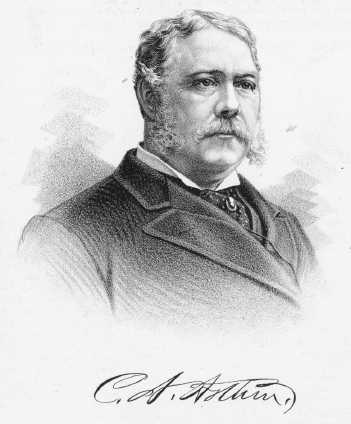100 CHESTER
A. ARTHUR.
CHESTER
A. ARTHUR.
followed their example. Before that the Sixth
Avenue Company ran a few special cars for colored
persons and the other lines refused to let them ride
at all.
General Arthur was a delegate to the
Convention at Saratoga that founded the Republican
party. Previous to the war he was Judge-Advocate of
the Second Brigade of the State of New York, and
Governor Morgan, of that State, appointed him
Engineer-in-Chief of his staff. In 1861, he was made
Inspector General, and soon afterward became
Quartermaster-General. In each of these offices he
rendered great service to the Government during the
war. At the end of Governor Morgan's term he resumed
the practice of the law, forming a partnership with
Mr. Ransom, and then Mr. Phelps, the District Attorney
of New York, was added to the firm. The legal practice
of this well-known firm was very large and lucrative,
each of the gentlemen composing it were able lawyers,
and possessed a splendid local reputation, if not
indeed one of national extent.
He always took a leading part in
State and city politics. He was appointed Collector of
the Port of New York by President Grant, Nov. 21,
1872, to succeed Thomas Murphy, and held the office
until July, 20, 1878, when he was succeeded by
Collector Merritt. Mr. Arthur was nominated on the
Presidential ticket, with Gen. James A. Garfield, at
the famous National Republican Convention held at
Chicago in June, 1880. This was perhaps the greatest
political convention that ever assembled on the
continent. It was composed of the leading politicians
of the Republican party, all able men, and each stood
firm and fought vigorously and with signal tenacity
for their respective candidates that were before the
convention for the nomination. Finally Gen. Garfield
received the nomination for President and Gen. Arthur
for Vice-President. The campaign which followed was
one of the most animated known in the history of our
country. Gen. Hancock, the standard-bearer of the
Democratic party, was a popular man, and his party
made a valiant fight for his election.
Finally the election came and the
country's choice was Garfield and Arthur. They were
inaugurated March 4, 1881, as President and
Vice-President. A few months only had passed ere the
newly chosen President was the victim of the
assassin's bullet. Then came terrible weeks of
suffering,--those moments of anxious suspense, when
the hearts of all civilized nations were throbbing in
unison, longing for the recovery of the noble, the
good President. The remarkable patience that he
manifested during those hours and weeks, and even
months, of the most terrible suffering man has often
been called upon to endure, was seemingly more than
human. It was certainly God-like. During all this
period of deepest anxiety Mr. Arthur's every move was
watched, and be it said to his credit that his every
action displayed only an earnest desire that the
suffering Garfield might recover, to serve the
remainder of the term he had so auspiciously begun.
Not a selfish feeling was manifested in deed or look
of this man, even though the most honored position in
the world was at any moment likely to fall to him.
At last God in his mercy relieved
President Garfield from further suffering, and the
world, as never as before in its history over the
death of any other man, wept at his bier. Then it
became the duty of the Vice President to assume the
responsibilities of the high office, and he took the
oath in New York, Sept. 20, 1881. The position was an
embarrassing one to him, made doubly so from the facts
that all eyes were on him, anxious to know what he
would do, what policy he would pursue, and who he
would select as advisers. The duties of the office had
been greatly neglected during the President's long
illness, and many important measures were to be
immediately decided by him; and still farther to
embarrass him he did not fail to realize under what
circumstances he became President, and knew the
feelings of many on this point. Under these trying
circumstances President Arthur took the reins of the
Government in his own hands; and, as embarrassing as
were the condition of affairs, he happily surprised
the nation, acting so wisely that but few criticised
(sic) his administration. He served the nation well
and faithfully, until the close of his administration,
March 4, 1885, and was a popular candidate before his
party for a second term. His name was ably presented
before the convention at Chicago, and was received
with great favor, and doubtless but for the personal
popularity of one of the opposing candidates, he would
have been selected as the standard-bearer of his party
for another campaign. He retired to private life
carrying with him the best wishes of the American
people, whom he had served in a manner satisfactory to
them and with credit to himself.

